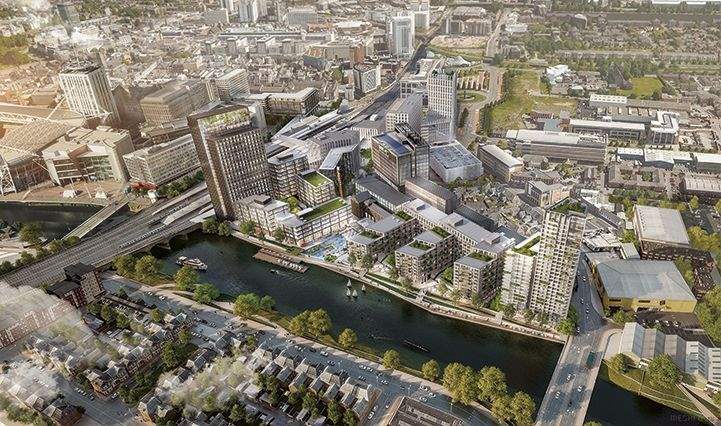Cardiff is on the verge of a sustained period of growth, but connectivity will be key to unlocking the full potential of the capital region
Punching above its weight
Cardiff is half the size of the next largest of the nine UK Core Cities, Liverpool, but it punches well above its weight. As the primary economic hub for South Wales, the influence of the city reaches well beyond its boundaries. Nearly 77,900 people, a third of the workforce, commute into the city each day which demonstrates the important economic and social role Cardiff plays in relation to the wider region. It is the sixth biggest retail centre in the UK, and attracts over 20 million visitors a year, bringing £1 billion to the local economy.

Strengthening markets
The real estate market has remained resilient despite the current political uncertainty. House prices are now 21% above their pre 2008 peak, in line with Birmingham and ahead of Manchester and Leeds. Cardiff saw house price growth of 6.1% in 2018, well above the England and Wales average of 1.9%.
Despite this strong price growth, housing remains relatively affordable in Cardiff, with an average house price to average earnings ratio of 6.58. This is in stark contrast to Bristol, which despite having similar average annual earnings of £27,000, has a house price to earnings ratio of 8.99. Cardiff is therefore well placed to attract those becoming priced out of areas on the other side of the River Severn.
Office space is similarly affordable, and attractive in comparison to Bristol. Grade A office rents in Cardiff are at £25 per sq. ft., with the potential to rise to £27 per sq. ft. for new supply.
In contrast, top rents in Bristol are reaching £35 per sq. ft., and affordability is becoming a constraint on further growth.

A growing city
Cardiff is projected to see population growth of 25% by 2034, a rate of growth that exceeds all the other UK Core Cities and is even higher than London. According to Oxford Economics, employment is forecast to grow by 12% by 2030, bringing 27,600 new jobs to the city, and outpacing the UK growth forecast of 8%.
The strongest forecast growth is expected to be in the professional, scientific and tech sector, which is expected to grow 60% by 2030. There is also strong growth forecast for the administration and information sectors, which are anticipated to grow by 56% and 46% respectively.
This projected growth is attracting investment. During 2018 Cardiff saw total commercial investment volumes of £408 million, 34% above the five-year annual average. 84% of investment was in office space, and 32% of investment came from overseas.
The influence of the city is also growing as it becomes increasingly well connected. There are currently 1.6 million people living within a 45 minute commute of Cardiff. Connectivity will be boosted by the electrification of the Great Western main line, cutting travel time to London to 105 minutes.
The recent removal of tolls on the bridges crossing the Severn is anticipated to boost travel between South Wales and South West England and bring a £1 billion boost to the Welsh economy.
The importance of linking Cardiff to the wider Welsh economy has been recognised in the Cardiff Capital Region city deal, established in 2016. The deal covers 10 local authorities in South East Wales, and aims to boost economic growth throughout the region. Investment of £1.2 billion has been committed by local and national government, with over £700 million of investment to fund the Metro network for South East Wales.
.png)
New homes delivery as a percentage of existing stock has fallen in Cardiff and is lagging behind the rate of growth in other cities
Source: StatsWales, MHCLG
Challenges ahead
However, there are key challenges which need to be addressed if Cardiff is to reach its full potential. The city has been failing to provide enough housing or commercial space to meet demand, and if this situation continues, the shortage of supply could lead to rising prices, threatening the affordability which is currently such a strength for the city.
There has been a consistent shortfall in housing delivery for the past five years. Delivery has averaged 490 homes per year, well short of the Local Plan target of 2,071 per year. 10 years ago, total housing stock was growing at a rate of 1.5%. Now, the growth rate is considerably slower. Over the past five years the rate of growth has averaged 0.3%, lagging behind the other UK Core Cities.
Office space is also in short supply, both as a consequence of limited Grade A development and the removal of secondary stock via office to student accommodation conversion. The city doesn’t currently have enough available Grade A office supply to meet the demand for even one years’ worth of take-up.
However, there is significant potential in the city centre and bay area for commercial led regeneration. Delivering this development and linking new housing to existing employment centres will be critical for the future economic success of Cardiff and the wider South East Wales region.
Read the articles within this publication below
.jpg)
.jpg)

.jpg)